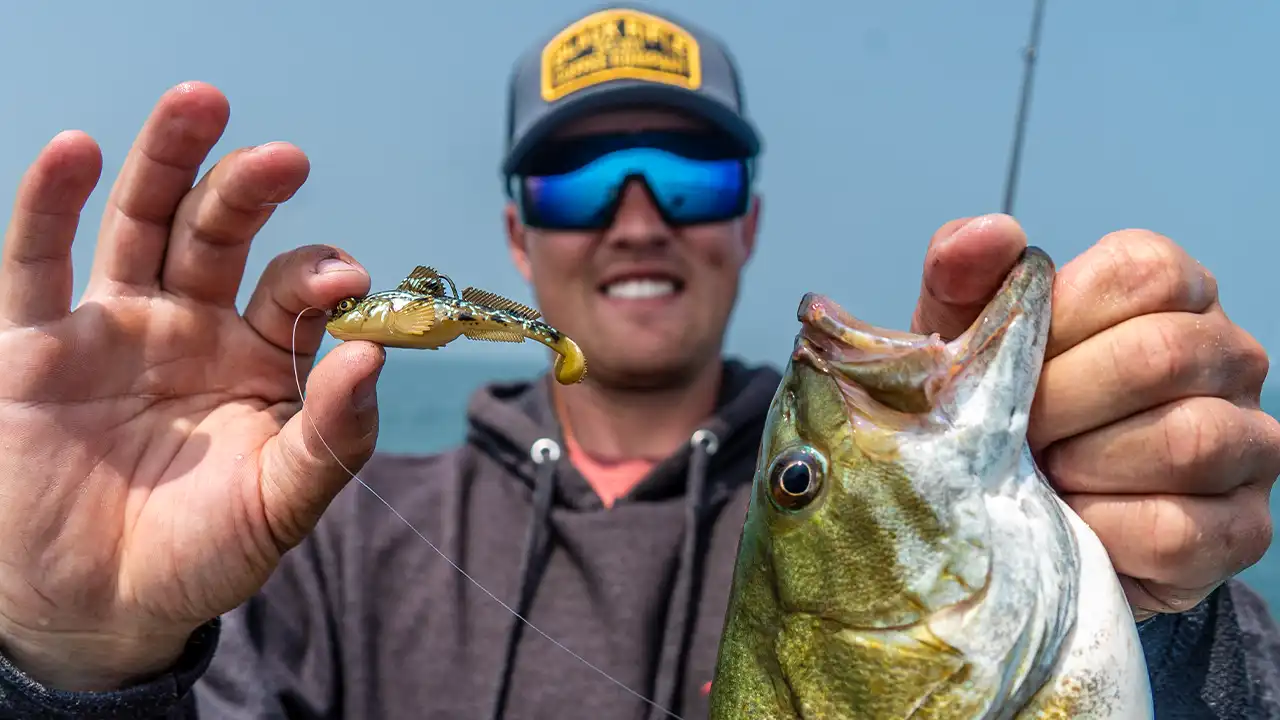Pro bass angler Jonathan Dietz takes to the expansive flats of Lake St. Clair and teaches us how to find and catch smallmouth bass keyed on eating round gobies relating to isolated rock piles. With a background in fisheries biology and a passion for Great Lakes smallmouth, Dietz understands the massive influence of the invasive gobies as a key forage. But this isn’t a Great Lakes or goby-specific tactic. His bottom-based swimbait method plays on fisheries nationwide, as sculpins and darter minnows exist nearly everywhere.
TACKLE LISTING (retail links)
- SWIMBAIT – Z-Man Gobius: Buy at FishUSA, Buy at Bass Pro Shops
- ROD – ARK Invoker Limited Edition Casting Rod, 7’2” medium-heavy: Buy at ARK
- Check out ARK Casting Rods at Tackle Warehouse
- REEL – ARK Fishing Gravity 3 Casting Reel, 8.1:1: Buy at Tackle Warehouse
- LINE – P-Line Tactical Fluorocarbon Line, 12-pound: Buy at FishUSA
- FISH FINDER (bow stack-top) – Garmin ECHOMAP Ultra 126sv Chartplotter/Fish Finder Combo: Buy at FishUSA, Buy at Bass Pro Shops
- FISH FINDER (bow stack-bottom) – Humminbird HELIX 10 CHIRP GPS G4N Fish Finder/Chartplotter: Buy at FishUSA, Buy at Bass Pro Shops
- TROLLING MOTOR – Garmin Force Trolling Motor: Buy at FishUSA, Buy at Bass Pro Shops
- LIVE SONAR – Garmin LiveScope Plus LVS34 – LiveScope + LVS34 System: Buy at FishUSA, Buy at Bass Pro Shops
- 360 IMAGING – Humminbird MEGA 360: Buy at Bass Pro Shops
- BOW GRAPH MOUNT – Precision Sonar Over and Under Bow Mount for Deck: Buy at Precision Sonar
TARGETING ISOLATED STRUCTURES
While grass beds and yellow perch can be the prevailing pattern on Lake St. Clair, hard-bottom areas consisting of rock and gravel are essential goby and smallmouth habitats. Dietz uses 360 and forward-facing sonar (FFS) to find “rough patches” and put his bait on target. Cross-cueing both technologies produces the best results. It’s often the case that bass hug the bottom (where crawfish and goby live), hiding in and among the rock and not visible on FFS. MEGA 360 shows the best rock patches and individual boulders where bass relate so you can make targeted casts. As Dietz demonstrates, it’s then common for the bass to rise and reveal their presence on FFS.
LIFELIKE GOBY IMITATIONS
While there are a lot of swimbaits on the market, few match the realism of the real thing. Dietz introduces the Z-Man Gobius, an ultra-lifelike goby-imitating swimbait, as one of his go-to lures for these conditions. He explains why this soft plastic-encased swimbait commonly outperforms other proven finesse smallmouth tactics. And unlike conventional paddle tail swimbaits rigged on a jig head, the Gobius’ unique design allows it to snake through rocky and grassy cover with minimal fouling. This makes it especially versatile on fisheries where bass make use of both hard and soft cover, as is the case on St. Clair. Time and time again, clear water and pressure also highlight the need for realism to fool and trigger bites, and the Gobius is a near exact match.
EQUIPMENT AND TECHNIQUE
While finesse smallmouth tactics and spinning rods are the primary tools of the smallmouth trade, Dietz likes sizing up to casting gear whenever possible. For him, it’s all about efficiency. A more powerful setup improves hook penetration while makes landing fish faster so he can quickly get back down and catch other one. He breaks down his equipment setup for his finesse power fishing technique, including rod, reel, and line. Notably, Dietz prefers a speedy 8.1:1 reel for rapid line pickup, essential for imparting erratic speed changes to the bait and reeling in fast to make new casts to hot fish.












